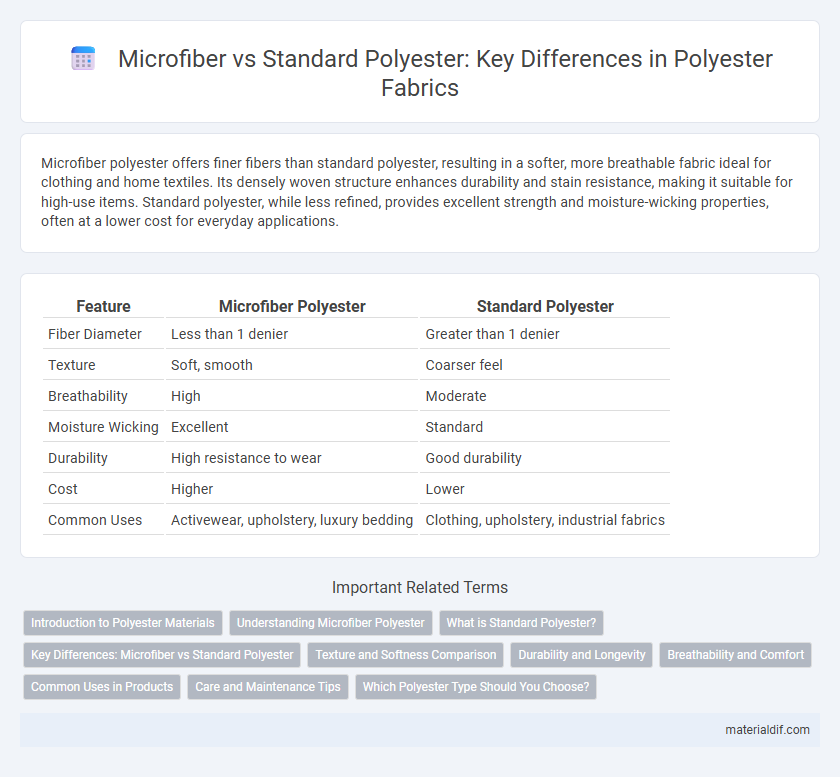Microfiber polyester offers finer fibers than standard polyester, resulting in a softer, more breathable fabric ideal for clothing and home textiles. Its densely woven structure enhances durability and stain resistance, making it suitable for high-use items. Standard polyester, while less refined, provides excellent strength and moisture-wicking properties, often at a lower cost for everyday applications.
Table of Comparison
| Feature | Microfiber Polyester | Standard Polyester |
|---|---|---|
| Fiber Diameter | Less than 1 denier | Greater than 1 denier |
| Texture | Soft, smooth | Coarser feel |
| Breathability | High | Moderate |
| Moisture Wicking | Excellent | Standard |
| Durability | High resistance to wear | Good durability |
| Cost | Higher | Lower |
| Common Uses | Activewear, upholstery, luxury bedding | Clothing, upholstery, industrial fabrics |
Introduction to Polyester Materials
Polyester materials are synthetic fibers derived from petroleum-based polymers, known for their durability and moisture resistance. Microfiber polyester, a refined version, features finer fibers measuring less than one denier, enhancing softness and breathability compared to standard polyester. Both types offer wrinkle resistance and quick-drying properties, but microfiber excels in lightweight comfort and superior fabric texture.
Understanding Microfiber Polyester
Microfiber polyester consists of ultra-fine fibers measuring less than one denier, offering a softer, more durable, and highly breathable fabric compared to standard polyester. Its advanced fiber structure enables superior moisture-wicking, enhanced stain resistance, and increased tensile strength, making it ideal for athletic wear and high-performance textiles. Microfiber polyester's finer weave also contributes to improved insulation while maintaining lightweight comfort, distinguishing it from conventional polyester fabrics.
What is Standard Polyester?
Standard polyester is a synthetic fiber made from polyethylene terephthalate (PET), widely used in textiles due to its durability, resistance to shrinking, and quick-drying properties. Unlike microfiber, which consists of ultra-fine fibers measuring less than one denier, standard polyester fibers are thicker, typically around 1.5 to 5 deniers, resulting in a heavier fabric with less softness and breathability. Common applications of standard polyester include clothing, upholstery, and industrial fabrics where sturdiness and easy care are prioritized.
Key Differences: Microfiber vs Standard Polyester
Microfiber polyester features ultra-fine fibers, typically less than one denier, offering superior softness, breathability, and moisture-wicking properties compared to standard polyester, which uses thicker fibers. The dense weave of microfiber enhances durability and stain resistance, making it ideal for performance textiles and high-end apparel, whereas standard polyester is more commonly found in basic clothing and home furnishings. Microfiber also provides better insulation and a smoother texture, contributing to its premium feel and higher manufacturing cost.
Texture and Softness Comparison
Microfiber polyester fibers are significantly finer than standard polyester, resulting in a smoother and more luxurious texture that mimics natural fabrics like silk or cotton. This ultra-fine fiber diameter enhances softness and provides a lightweight, breathable feel, making microfiber polyester ideal for high-quality apparel and bedding. Standard polyester has a coarser texture and a firmer hand, which can feel less comfortable against the skin but offers greater durability and wrinkle resistance.
Durability and Longevity
Microfiber polyester features finer fibers that enhance durability by resisting wear, tear, and pilling better than standard polyester. Its denser weave provides superior longevity, maintaining fabric integrity and color retention through multiple wash cycles. Standard polyester, while durable, may degrade faster over time due to thicker fibers that are more prone to abrasion and fading.
Breathability and Comfort
Microfiber polyester features finer fibers that enhance breathability by allowing better air circulation compared to standard polyester, reducing heat retention and moisture buildup. Its smooth, lightweight texture offers superior comfort against the skin, minimizing irritation and promoting a softer feel. Standard polyester tends to trap heat and moisture, making it less breathable and less comfortable for extended wear.
Common Uses in Products
Microfiber polyester is commonly used in high-performance activewear, cleaning cloths, and upholstery due to its fine fibers that enhance softness and moisture-wicking properties. Standard polyester is widely found in everyday clothing, home furnishings, and industrial textiles, valued for its durability and cost-effectiveness. Both types serve distinct functions: microfiber excels in applications requiring lightweight, breathable fabrics, while standard polyester is preferred for robust, long-lasting materials.
Care and Maintenance Tips
Microfiber polyester requires gentler care, with washing in cold water and avoiding high heat drying to prevent fiber damage and maintain softness. Standard polyester can tolerate warmer water and higher heat but benefits from using mild detergents and avoiding bleach to preserve fabric quality. Both fabrics should be air-dried or tumble-dried on low to extend lifespan and reduce pilling.
Which Polyester Type Should You Choose?
Microfiber polyester offers finer fibers, resulting in a softer texture, higher durability, and superior moisture-wicking capabilities compared to standard polyester. Standard polyester features thicker fibers, making it more affordable and ideal for heavy-duty applications where cost-efficiency is key. Choosing microfiber polyester is best for premium comfort and performance, while standard polyester serves well in budget-conscious, robust uses.
Microfiber vs Standard Polyester Infographic

 materialdif.com
materialdif.com